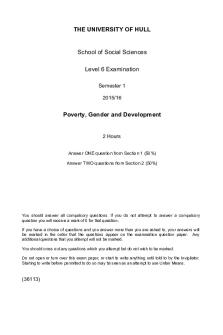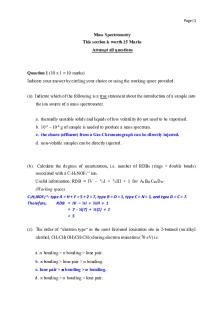Sample/practice exam 2016, questions - mass spectrometry PDF

| Title | Sample/practice exam 2016, questions - mass spectrometry |
|---|---|
| Course | Fundamentals Of Chemistry A |
| Institution | La Trobe University |
| Pages | 7 |
| File Size | 244.1 KB |
| File Type | |
| Total Downloads | 2 |
| Total Views | 173 |
Summary
Mass Spectrometry
...
Description
Page|1
Mass Spectrometry This section is worth 25 Marks Attempt all questions
Question 1 (10 x 1 = 10 marks) Indicate your answer by circling your choice or using the working space provided.
(a) Indicate which of the following is a true statement about the introduction of a sample into the ion source of a mass spectrometer.
a. thermally unstable solids and liquids of low volatility do not need to be vaporised. b. 10-3 – 10-6 g of sample is needed to produce a mass spectrum. c. the eluate (effluent) from a Gas Chromatograph can be directly injected. d. non-volatile samples can be directly injected.
(b) Calculate the degrees of unsaturation, i.e. number of RDBs (rings + double bonds) associated with a C7H5NOF2+• ion. Useful information: RDB = IV – 1/2I + 1/2III + 1 for AI BII CIII DIV (Working space)
(c) The order of “electron type” as the most favoured ionisation site in 2-butanol (an alkyl alcohol, CH3CH(OH)CH2CH3) during electron ionisation (70 eV) is:
a. bonding > bonding > lone pair. b. bonding > lone pair > bonding. c. lone pair > bonding > bonding. d. bonding > bonding > lone pair.
Page|2
(d)
The low-resolution mass spectrum of the polycyclic aromatic hydrocarbon pyrene (C16H10) exhibits a signal at m/z 178 due to the molecular ion (M) which is also the base peak. Pyrene contains only carbon and hydrogen. Indicate the most likely relative intensity (%) of the M+1 signal at m/z 179. Useful information, Isotope abundance factors (%) of M+1 relative to M for CnHm: C 1.08n, H 0.012m
a. 10% b. 14% c. 17% d. 26%
(e) Indicate which of the following is a true statement about mass analysers used in mass spectrometry.
a. the energy of ions is directly proportional to their charge. b. a quadrupole filter uses a large magnet to deflect ions. c. ions are deflected in a simple trajectory in a quadrupole filter. d. low energy ions are substantially deflected.
(f) The molecular weight of 2-chlorohexane (C6H13Cl) is 120.62018. The low-resolution mass spectrum of 2-chlorohexane exhibits a group of signals at m/z 120, 121, 122 and 123. Which of these signals is due to the molecular ion? Useful information, Isotope abundance (%): 1H 99.99, 2H 0.01, 12C 98.9, 13C 1.1, 35Cl 75.8, 37Cl 24.2.
a. m/z 120 b. m/z 121 c. m/z 122 d. m/z 123
Page|3
(g) The low-resolution mass spectrum of 2-chlorohexane exhibits a group of signals associated with the intact molecule at m/z 120, 121, 122 and 123. What isotopes are responsible for the signal at m/z 122? Useful information, common isotopes: 1H & 2H, 12C & 13C,35Cl & 37Cl, 79Br & 81Br. a. 12C, 35Cl, 1H b. 12C, 35Cl, 2H c. 12C, 37Cl, 1H d. 13C, 37Cl, 1H
(h) Calculate the resolving power (Rp) of a mass spectrometer for two adjacent signals in a mass spectrum due to O3+ at m/z 47.9847 and H2NO2+ at m/z 48.0085. m Useful information: R p 1 Δm
(Working space)
(i) The mass spectra of aliphatic alcohols often exhibit a signal at 18 mass units less than the molecular ion. What fragmentation process is responsible for this signal? (write your answer here)
(j) The term ‘mean free path’ is regularly used in mass spectrometry. What is meant by this term? (write your answer here)
Page|4
Question 2 (4 marks) A confiscated sample is suspected to be heroin (C 21H23NO 5, MW 369.41, structure below).
Briefly, discuss how forensic scientists could confirm the sample as heroin by using different mass spectrometry techniques. (Hint: consider the different information obtained from the different ionisation techniques) (use the space below and on the opposite page, if necessary, for your response)
Page|5
Question 3 (4 marks)
Chemical ionisation can be used to produce ions for analysis in mass spectrometry.
(a) Write a series of chemical reactions to show how a protonated molecule ion might be formed for methylamine (a primary alkyl amine) using ammonia as a reagent gas for chemical ionisation. (3 marks)
(b) Name another gas that is commonly used as a reagent gas for chemical ionisation. (1 mark)
Page|6
Question 4 (3 marks)
The low-resolution electron ionisation mass spectrum of 2-hexanone (C 6H12O, MW 100.16) is shown below.
CH3 H2 C
H3C
58
C H2
C C H2
O
2-hexanone
(a) Name the characteristic fragmentation mechanism observed for some carbonyl compounds that is responsible for the strong signal at m/z 58. (1 mark)
(b) Draw the structure of a likely ion responsible for the signal at m/z 58. (clearly indicate any charges or unpaired electrons) (1 mark)
(c) Draw the structure of a likely ion responsible for the signal at m/z 85. (clearly indicate any charges or unpaired electrons) (1 mark)
Page|7
Question 5 (4 marks)
Eugenol is a major component of the essential oil extracted from cloves and cinnamon. The high-resolution mass spectrum obtained by the electron ionisation of a sample extracted from cloves shows a molecular ion at m/z 164.08373. Investigation of the fragmentation ions in the mass spectrum indicates the presence of two oxygen atoms in the molecular ion. Determine the likely molecular formula of the chemical species responsible for the molecular ion. Clearly show all methods and calculations used to determine your answer. Useful information, Isotope mass (Da): 1H 1.00783, 12C 12.00000, 16O 15.99491....
Similar Free PDFs

Principles of Mass Spectrometry
- 5 Pages

Isotopes and Mass Spectrometry
- 20 Pages

Atomic MASS Spectrometry
- 28 Pages

Exam 2015 - 2016, questions
- 6 Pages

Exam January 2016, questions
- 4 Pages

Exam 2016, questions
- 18 Pages

Exam 2016, questions
- 6 Pages

Exam 2016, questions
- 29 Pages

Exam 2013-2016, questions
- 24 Pages

Exam 2016, questions
- 2 Pages

Exam June 2016, questions
- 7 Pages

Exam 2016, questions
- 6 Pages

Exam 2016, questions
- 2 Pages

Exam 2016, questions
- 9 Pages
Popular Institutions
- Tinajero National High School - Annex
- Politeknik Caltex Riau
- Yokohama City University
- SGT University
- University of Al-Qadisiyah
- Divine Word College of Vigan
- Techniek College Rotterdam
- Universidade de Santiago
- Universiti Teknologi MARA Cawangan Johor Kampus Pasir Gudang
- Poltekkes Kemenkes Yogyakarta
- Baguio City National High School
- Colegio san marcos
- preparatoria uno
- Centro de Bachillerato Tecnológico Industrial y de Servicios No. 107
- Dalian Maritime University
- Quang Trung Secondary School
- Colegio Tecnológico en Informática
- Corporación Regional de Educación Superior
- Grupo CEDVA
- Dar Al Uloom University
- Centro de Estudios Preuniversitarios de la Universidad Nacional de Ingeniería
- 上智大学
- Aakash International School, Nuna Majara
- San Felipe Neri Catholic School
- Kang Chiao International School - New Taipei City
- Misamis Occidental National High School
- Institución Educativa Escuela Normal Juan Ladrilleros
- Kolehiyo ng Pantukan
- Batanes State College
- Instituto Continental
- Sekolah Menengah Kejuruan Kesehatan Kaltara (Tarakan)
- Colegio de La Inmaculada Concepcion - Cebu

